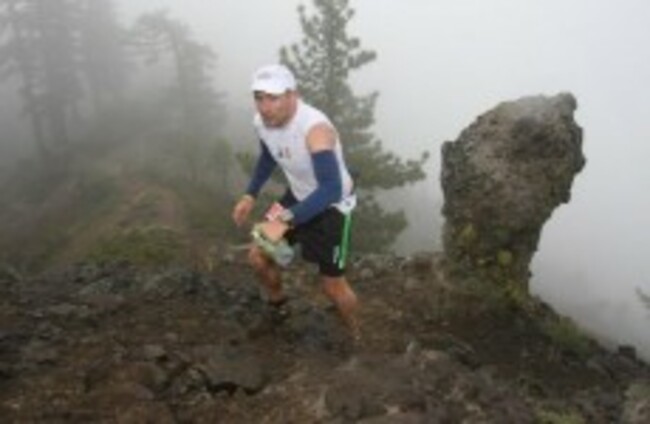THERE ARE THREE questions that close the opening chapter of Dean Karnazes’ best-selling book ‘Ultramarathon Man: Confessions of an all-night runner’.
“What am I running from?”
“Who am I running for?”
“Where am I running to?”
For everyone, from those who dust down their runners once a year for a fun run to your friend who is planning on completing her first sub-three hour marathon this year, the answer to those questions will be very different.
And, despite the fact he’s about to attempt what is widely considered the world’s toughest foot race this evening, Padraig Mullins is still unsure as to what his answers would be.
Indeed, the self-employed electrician — originally from Rathpeacon in Cork, but living in Boston since 2004 — is not entirely sure sure how the running bug bit in the first place, though it may well having something to do with watching his father, Tommy, running ten marathons when he was younger.
He didn’t actually start running himself until he was much older, however.
“I tried my hand at most sports as a kid and played hurling and football with Na Piarsaigh, but I was never into athletics, so I only started running in 2006 and, really, I knew nothing about running,” Mullins told The42 this week.
“It was just one of those things you do, a marathon, to mark off your bucket list and I stopped running after that.
“But then I read a book, ‘Ultramarathon Man’ and I started running again and I suppose it really took off when I was selected for the New York Marathon in 2010.
“I said nothing to nobody about running New York, I just wanted to build up my fitness for it and when I completed the race, I don’t know really why, but the longer distances became more attractive to me and I was just gripped by it.”
The 33-year old says that while ultra-running used to be the preserve of older runners, he is now one of the older participants as more and more young athletes are attracted to distance racing in the US.
“It’s becoming very popular over here and a lot of races are selling out faster and faster. When I first got into it, you could probably sign up for a race just a week beforehand, now the ultras are constantly selling out months in advance.”
This evening, Mullins puts his love for ultra-running to the ultimate test when he takes part in the Badwater 135 mile (217km) race from Death Valley to Mount Whitney in California.
What makes Badwater unique is its punishing mix of terrain and temperature.
The start line in Death Valley is located on the lowest elevation in North America at 280ft (85m) below sea level while the finish line is some 8,300ft (2,530m) above. To put the elevation of the finish in context, it’s approximately half the height of Mount Everest’s base camp.
Not only that, but during the 217km of the race, competitors will face three mountain ranges with a total of 14,600ft (4,450m) of cumulative vertical ascent and 6,100ft (1,859m) of cumulative descent.
As if that wasn’t bad enough, temperature can reach over 49°C with very little in the way of shade on the course. Because of this, between 20 and 40 of the 100 competitors selected to take part every year, fail to finish the race.
So what would make anyone want to take part?
“It’s all about the belt buckle,” he says with a laugh.
“It’s amazing how much that can keep you going in training towards the end. It’s really hard to explain to people who don’t run what the belt buckle actually means but it’s so symbolic for everyone involved in ultra-running.”
With Mullins living in Massachusetts, he’s had to be creative in his training.
“The Boston winter certainly toughens you up, but it’s not ideal for preparing for the conditions in Badwater so I’ve done a good few sessions running in the sauna and tried some Bikram Yoga to get used to the heat.
“I only found out I was accepted into the race in late January, early February so it was then that I started to up the mileage. I’d do anywhere between 60 and 100 miles (100-160km) per week. I started at 60 and then upped it by about 10 miles per week, dropping back in mileage every third week to give the body a break.
“I also had a 24 hour race in May which I used as a training run and I did 130 miles (210km) there so that was great to get under my belt and I’ve done a couple of marathons and a couple of 50km races too to keep me ticking over in between.”
Mullins admits he’s been “very, very” lucky in avoiding injury having spent six weeks last year unable to run a single step because he’d failed to listen to his body.
Running for more than 24 hours, you have to be mentally fit and the long training runs help Mullins with pushing through when his mind is screaming at him to stop. When he reaches the start line this evening, however, he won’t be alone.
Like most competitors, Mullins will be followed by a support team — which is made up of his mother Helena, girlfriend Wendy Andre and his friend Brian Tjersland — who will follow him in a truck and prepare the drinks and food he’ll need to get through the race.
Not that completion is all Mullins has on his mind.
“I’d love to get under 30 hours and it’s definitely possible. Top ten would be great but everything would have to go perfectly for me for that to happen.
“I’ll be competitive, definitely.”














I’m going to take a tenner on van aert for the green Jersey
@Andrew Tuite: could be the big surprise of the tour. what odds would you get?
@Andrew Tuite: He’ll be working for Groenewegen’s leadout which diminishes his chances. Also his first GT…but he’s a huge talent, bigger surprises have happened…
@Brendan Heery: nothing online as yet.